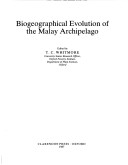Oxford Monographs on Biogeography
1 total work
Biogeographical Evolution of the Malay Archipelago
Published 22 October 1987
During the 1980s there were significant advances in our understanding of the biogeographical history of the region between Asia and Australia. The Malay peninsula arose by mid-Tertiary collision of Gondwana and Laurasia, but evidence from the ranges of many organisms suggests that there were earlier north-south contacts. Recently discovered fragments of Gondwana embedded in South-East Asia, which have drifted north of the Australian margin, could have provided island stepping stones. Angiosperms may have evolved and diversified on such an archipelago. Present ranges reflect past climates, and periodic drier episodes have now been found back into the Tertiary period, including in Malaya. Here, twelve specialists describe both these views and the remaining problems in biogeographical reconstruction, in a collection based on a symposium from the Third International Congress of Systematic and Evolutionary Biology.
